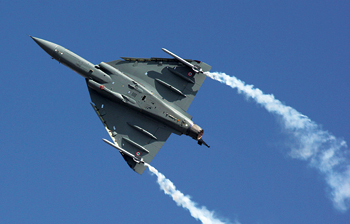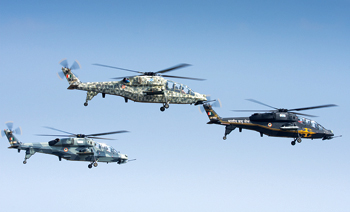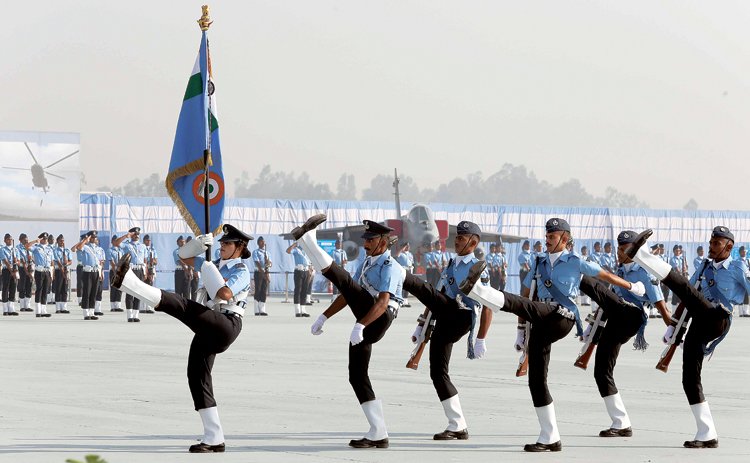INDIAN ARMED FORCES CHIEFS ON OUR RELENTLESS AND FOCUSED PUBLISHING EFFORTS

The insightful articles, inspiring narrations and analytical perspectives presented by the Editorial Team, establish an alluring connect with the reader. My compliments and best wishes to SP Guide Publications.

"Over the past 60 years, the growth of SP Guide Publications has mirrored the rising stature of Indian Navy. Its well-researched and informative magazines on Defence and Aerospace sector have served to shape an educated opinion of our military personnel, policy makers and the public alike. I wish SP's Publication team continued success, fair winds and following seas in all future endeavour!"

Since, its inception in 1964, SP Guide Publications has consistently demonstrated commitment to high-quality journalism in the aerospace and defence sectors, earning a well-deserved reputation as Asia's largest media house in this domain. I wish SP Guide Publications continued success in its pursuit of excellence.
FIRST & EXCLUSIVE TO SP’S
“IAF’s threat appreciation always caters for likely scenarios & a scan of global capabilities to arrive at optimum force structure & desired operational prowess”
On the occasion of the 89th Anniversary of the Indian Air Force (IAF), Air Chief Marshal V.R. Chaudhari, PVSM AVSM VM ADC, Chief of the Air Staff spoke exclusively to Jayant Baranwal, Editor-in-Chief, SP’s Aviation

SP’s Aviation (SP’s): Can you enlighten us on your overall modernisation plans and the timelines towards induction also for the ones listed below?
- 114 MRFA
- Combat Drones
- Air to Air Refuelling Aircraft
- 5th–Gen fighter Capability Acquisition
CHIEF OF THE AIR STAFF (CAS):
114 MULTI-ROLE FIGHTER AIRCRAFT.
We plan to induct 114 MRFAs as the lead agency under Make in India provisions in a phased manner. The Air Staff Qualitative Requirements (ASQRs) for the current proposal are being finalized.
COMBAT DRONES.
We have a road map for phased induction of combat drones to meet both short term and long term operational requirements. Efforts are being made to indigenously design and develop Combat drones involving R&D agencies. The recently concluded ‘Mehar Baba competition’ in swarm drone category has given us more indigenous options with private players as stakeholders.
FLIGHT REFUELLER AIRCRAFT.
Procurement of additional FRAs has been initiated through acquisition and leasing model which has been recently incorporated in DAP 2020. Towards leasing of FRA, several global contenders have shown interest in response to our RFI. The process of acquisition of FRA is under process.
5TH GENERATION FIGHTER CAPABILITY ACQUISITION.
The AMCA fifth plus generation prototype is expected to commence flight test activities in the next few years. We are fully supportive of the AMCA programme, and if it proceeds as per the planned schedule, we will be able to operationally induct it in the next decade.
SP’s: As on date, how do you compare the capabilities of Indian Air Force versus Chinese Air Force which may not be qualitatively very strong but in terms of numbers they do appear to have some edge? How about in Eastern Ladakh and North-Eastern to be little bit more specific?
CAS: IAF’s threat appreciation always caters for likely scenarios and a scan of global capabilities to arrive at optimum force structure and desired operational prowess. The IAF, like all major air forces, has continued its focus on induction of platforms, weapon systems and emerging technologies. IAF plans for dominance of the vertical domain through optimal use of its air power assets. With motivated personnel, capable equipment and joint planning, IAF is always operationally ready for any contingencies. Although our neighbours are rapidly building both assets and infrastructure, our plans and capabilities are evolving to cater for this.
SP’s: Are we ready, if needed, to take on two-front War? How – please elaborate?
CAS: IAF CONOPS (Concept of Operations), war time policies and plans are calibrated based on expected and emerging threats. We remain prepared whilst we continuously enhance our capabilities to ensure a robust response when challenged.
SP’s: Fighter Squadron numbers are still way beyond under control. What all is being planned to not only arrest the problem but also to ensure that our Air Force is well equipped and well shielded by the necessitated Fighter Capabilities?


CAS: IAF has planned for build up of its fighter fleet over the coming two decades. This includes 83 LCA MK1A, 12 Su-30 MKI, 21 MiG-29s, 114 MRFA and upto seven Sqns of AMCA. The plan caters to a force build up along with filling of gaps when older types and squadrons are phased out. Apart from new inductions, we are upgrading our current fighter inventory with advanced avionics and weapons systems to meet our operational requirements.
SP’s: How do you perceive the formation of Theatre Commands? Request your little detailed thoughts.
CAS: There is no doubt that greater jointness and integration is the need of the hour. Various possible solutions to achieve this are under discussion and being deliberated. This is the most important higher defence reform which will dictate the way we will fight in the future and the IAF is fully committed to achieve this integration. In order for it to succeed we must evolve an appropriate robust and truly integrated structure, which is future ready, and transforms our comprehensive combat capability to a higher level. We must leverage the strength and doctrinal utilisation of each Service effectively and factor this aspect while forming the structure of joint Commands.
SP’s: What are the lessons learnt out of Drones attacks? Can you enlighten us on the plans to counter such new threats?
CAS: The vulnerabilities which led to the Jammu drone attack have been suitably addressed. IAF had already instituted measures for handling rogue drone threats at its bases. These include soft and hard kill options, procedures and actions to be taken and coordination required with civil police to counter such threats.
SP’s: What are the plans towards Space-based capabilities?
CAS: The Space domain is likely to dominate the future strategic spectrum. To this end, Defence Space Agency (DSA) has been formed to bring about the required synergy for operational control of all space resources in achieving our national military objectives.
“IAF is always operationally ready for any contingencies. Our neighbours are rapidly building both assets and infrastructure, our plans and capabilities are evolving to cater for this.”
In the space domain, we are working towards seamlessly integrating the output from space based assets into our Intelligence matrix. We are utilising considerable space based bandwidth towards maximising our network and communications redundancies.
SP’s: What are the incentives offered today to airmen and to ground-crew boosting their morale high, consistently?
CAS: Irrespective of rank and file, empowerment of all air warriors in decision making and leadership skills is the core focus area. This has been boosted by several HR policies where mid level supervisors are empowered with both responsibility and authority. IAF has instituted measures to improve Quality of Life of air-warriors irrespective of their place of posting keeping in mind the hardship of the tenure as an index (Our Air Force Schools are slated to be up-graded with new infrastructure and improvement in academic and co-curricular spheres). We have revised the policy of tenures to suit domestic needs and revisited promotion policies for our personnel to suit individual aspirations.

“We must leverage the strength and doctrinal utilisation of each Service effectively and factor this aspect while forming the structure of joint Commands”
SP’s: Self-sufficiency of Indian Aerospace Industry is a longdrawn process. How do you perceive its evolution?
CAS: The vision of “Atmanirbhar Bharat” is central to our force planning process for the future. MiG-21, MiG-27, MiG-29, Mirage, Jaguar, Dornier 228, An-32 and Mi-17 have been successfully upgraded with the participation of domestic industry. Support for LCA, LCH, LUH, HTT-40 and the recently concluded deal of C295 manufacturing and assembly in India etc indicate the faith placed in Indian Aerospace Industry. Today, almost all the IAF’s ground based radars are indigenously manufactured. We are also inducting many indigenous missile systems (Astra, AKASH, NGARM, etc) and locally manufactured EW suites for our fighter fleet. Many critical operation support systems are being developed by Indian Firms. With this growth curve and our organic requirement, the Indian Aerospace industry has a golden opportunity to evolve and grow rapidly.





